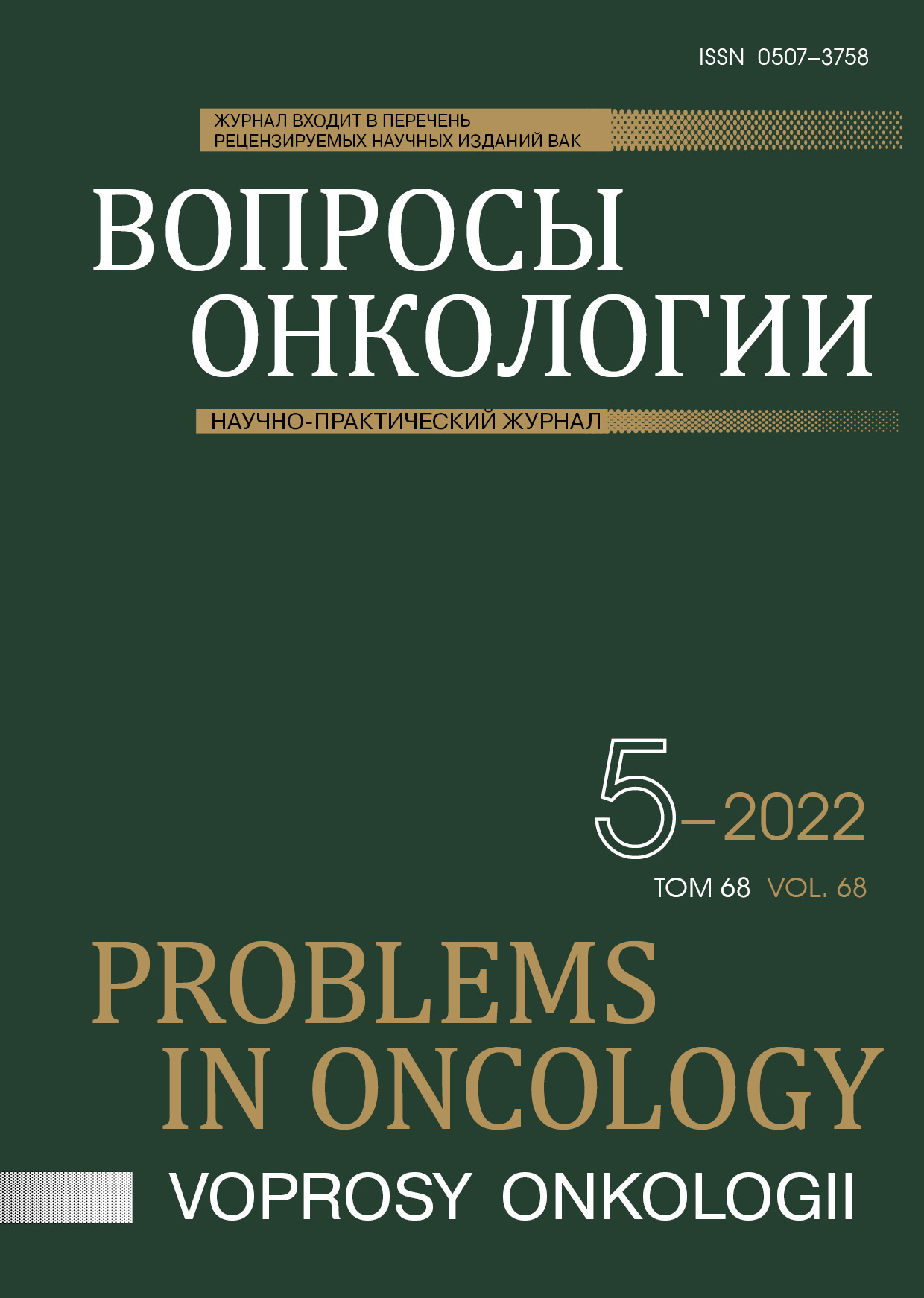Abstract
Introduction. Breast cancer is the most common tumor localization in heritable TP53-related cancer syndrome (hTP53rc), previously called «Li-Fraumeni syndrome». This syndrome is characterized by the occurrence of a hereditary mutation in the TP53 gene.
We wanted to demonstrate the relatively high incidence of hTP53rc in the structure of hereditary breast tumors, as well as to present a correct algorithm for the diagnosis of TP53-associated breast cancer in the Russian population.
Aim. To study the incidence and spectrum of hereditary mutations in the TP53 gene in breast cancer patients.
Materials and methods. We studied 1726 samples from breast cancer patients using next generation sequencing (NGS) to detect hereditary mutations in the TP53, BRCA1/2 genes. The feature of this study was the creation of «enriched» sample collection ― all samples from patients with any mutations in the BRCA1/2 genes were excluded from sample group using a special algorithm. CHEK2, NBS1, and BLM genes in 1322 from 1726 samples were additionally tested by PCR for the most common mutations in the population: CHEK2 del5395 (del ex9-10), CHEK2 c.444+1G>A [IVS2+1G>A], CHEK2 1100delC, NBS1 657del5, BLM p.Q548X [c.1642C>T]. Such a technique was used for detecting the carriership of double mutations and could make it possible to assess the features of the clinical manifestations of such situations in case of their detection. Usage of an algorithm based on NGS with the study of several genes made it possible to exclude samples with mutations and form a final sample group by which the occurrence of hTP53rc was calculated.
Results. The occurrence of hTP53rc in the formed sample was 10/1494, which is 0.67%.
Conclusion. The frequency of hTP53rc in the Russian population is obviously insufficiently estimated. The contribution of hTP53rc to the structure of hereditary breast cancer should be taken into account.
References
Frebourg T, Bajalica-Lagercrantz S, Oliveira C et al. Guidelines for the Li–Fraumeni and heritable TP53-related cancer syndromes // Eur. J. Hum. Genet. 2020;28:1379–1386. doi:10.1038/s41431-020-0638-4
Kratz CP, Achatz MI, Brugières L et al. Cancer Screening Recommendations for Individuals with Li-Fraumeni Syndrome // Clinical cancer research: an official journal of the American Association for Cancer Research. 2017;23(11):38–45. doi:10.1158/1078-0432.CCR-17-0408
Mathias C, Bortoletto S, Centa A et al. Frequency of the TP53 R337H variant in sporadic breast cancer and its impact on genomic instability // Sci. Rep. 2020;10(1):16614. doi:10.1038/s41598-020-73282-y
Janavičius R. Founder BRCA1/2 mutations in the Europe: implications for hereditary breast-ovarian cancer prevention and control // The EPMA J. 2010;1(3):397–412. doi:10.1007/s13167-010-0037-y
Bougeard G, Renaux-Petel M, Flaman JM et al. Revisiting Li-Fraumeni Syndrome From TP53 Mutation Carriers // J. Clin. Oncol. 2015;33(21):2345–2352. doi:10.1200/JCO.2014.59.5728
Li FP, Fraumeni JFJr, Mulvihill JJ et al. A cancer family syndrome in twenty-four kindreds // Cancer Res. 1988;48(18):5358–5362.
Birch JM, Hartley AL, Tricker KJ et al. Prevalence and diversity of constitutional mutations in the p53 gene among 21 Li-Fraumeni families // Cancer Res. 1994;54(5):1298–1304.
Eeles RA, Bartkova J, Lane DP et al. The role of TP53 in breast cancer development // Cancer Surv. 1993;18:57–75.
Eeles RA. Germline Mutations in the TP53 Gene in Breast and Other Cancers // Thesis. Institute of Cancer Research. University of London, 2000.
Masciari S, Dillon DA, Rath M et al. Breast cancer phenotype in women with TP53 germline mutations: a Li-Fraumeni syndrome consortium effort // Breast cancer research and treatment. 2012;133(3):1125–30. doi:10.1007/s10549-012-1993-9
Chen H, Wu J, Zhang Z et al. Association Between BRCA Status and Triple-Negative Breast Cancer: A Meta-Analysis // Frontiers in pharmacology. 2018;9(909). doi:10.3389/fphar.2018.00909
Wei G, Teng M, Rosa M et al. Unique ER PR expression pattern in breast cancers with CHEK2 mutation: a hormone receptor and HER2 analysis based on germline cancer predisposition genes // Breast Cancer Res. 2022;24(11). doi:10.1186/s13058-022-01507-1
Sokolenko AP, Sokolova TN, Ni VI et al. Frequency and spectrum of founder and non-founder BRCA1 and BRCA2 mutations in a large series of Russian breast cancer and ovarian cancer patients // Breast Cancer Res. Treat. 2020;184(1):229–235. doi:10.1007/s10549-020-05827-8
Prokofyeva D, Bogdanova N, Dubrowinskaja N et al. Nonsense mutation p.Q548X in BLM, the gene mutated in Bloom's syndrome, is associated with breast cancer in Slavic populations // Breast Cancer Res. Treat. 2013;137(2):533–9. doi:10.1007/s10549-012-2357-1
di Masi A, Antoccia A. NBS1 Heterozygosity and Cancer Risk // Curr. Genomics. 2008;9(4):275–281. doi:10.2174/138920208784533610
Cybulski C, Wokołorczyk D, Jakubowska A et al. Risk of breast cancer in women with a CHEK2 mutation with and without a family history of breast cancer // J. Clin. Oncol. 2011;29(28):3747–52. doi:10.1200/JCO.2010.34.0778
Ricordel C, Labalette-Tiercin M, Lespagnol A. EFGR-mutant lung adenocarcinoma and Li-Fraumeni syndrome: report of two cases and review of the literature // Lung Cancer. 2015;87(1):80–84. doi:10.1016/j.lungcan.2014.11.005
Shodai T, Kazuhiro S, Koya K et al. Lung adenocarcinoma in a patient with Li–Fraumeni syndrome bearing a novel germ-line mutation, TP53R333Vfs*12 // Japanese Journal of Clinical Oncology. 2020;50(10):1214–1217. doi:10.1093/jjco/hyaa095
Renaux-Petel M, Charbonnier F, Théry JC et al. Contribution of de novo and mosaic TP53 mutations to Li-Fraumeni syndrome // J. Med. Genet. 2018;55(3):173–180. doi:10.1136/jmedgenet-2017-104976

This work is licensed under a Creative Commons Attribution-NonCommercial-NoDerivatives 4.0 International License.
© АННМО «Вопросы онкологии», Copyright (c) 2022
